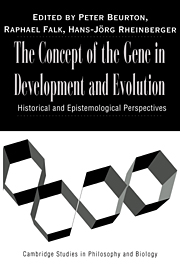Book contents
- Frontmatter
- Contents
- Introduction
- List of Authors
- PART ONE GENES AND TRAITS
- PART TWO EXTRACTING THE UNITS OF HEREDITY
- PART THREE GENETIC PROGRAMS AND DEVELOPMENTAL GENES
- 7 Decoding the Genetic Program: Or, Some Circular Logic in the Logic of Circularity
- 8 Genes Classical and Genes Developmental: The Different Use of Genes in Evolutionary Syntheses
- 9 The Developmental Gene Concept: History and Limits
- PART FOUR CONCEPTUAL PERSPECTIVES
- FINAL REVIEW
- Glossary
- Index
9 - The Developmental Gene Concept: History and Limits
from PART THREE - GENETIC PROGRAMS AND DEVELOPMENTAL GENES
Published online by Cambridge University Press: 12 January 2010
- Frontmatter
- Contents
- Introduction
- List of Authors
- PART ONE GENES AND TRAITS
- PART TWO EXTRACTING THE UNITS OF HEREDITY
- PART THREE GENETIC PROGRAMS AND DEVELOPMENTAL GENES
- 7 Decoding the Genetic Program: Or, Some Circular Logic in the Logic of Circularity
- 8 Genes Classical and Genes Developmental: The Different Use of Genes in Evolutionary Syntheses
- 9 The Developmental Gene Concept: History and Limits
- PART FOUR CONCEPTUAL PERSPECTIVES
- FINAL REVIEW
- Glossary
- Index
Summary
ABSTRACT
Today, developmental genes are at the focus of attention of many developmental biologists as well as evolutionary biologists and paleontologists. The formation of the concept of developmental genes progressed stepwise during the twentieth century. However, the significance of these genes was not fully recognized until the end of the 1980s when, thanks to new genetic engineering techniques, homologous genes were isolated from very different organisms, ranging from Drosophila or nematodes to mammals and humans. Such genes are highly conserved. The proteins encoded by developmental genes are transcription factors that regulate the expression of other genes and components of the cellular signaling pathways that allow cells to communicate with their neighbors. Frequently, the conservation is not limited to one gene but extends to the entire pathway.
The significance of these genes remains puzzling: Their functions during development are difficult to state precisely, as well as the role they play in the evolutionary shifts such as the Cambrian explosion. Are they the master genes that guide development and constrain evolution or only the toolbox with which evolution tinkers? The very notation of developmental genes appears increasingly problematic.
The concept of the developmental gene occupies a central position in contemporary biological research at the crossroads between developmental and evolutionary biology. In this brief text, I would like to outline the major steps that led to the formation of this concept and emphasize some of the difficulties encountered by biologists in its present-day use.
- Type
- Chapter
- Information
- The Concept of the Gene in Development and EvolutionHistorical and Epistemological Perspectives, pp. 193 - 216Publisher: Cambridge University PressPrint publication year: 2000
- 9
- Cited by



